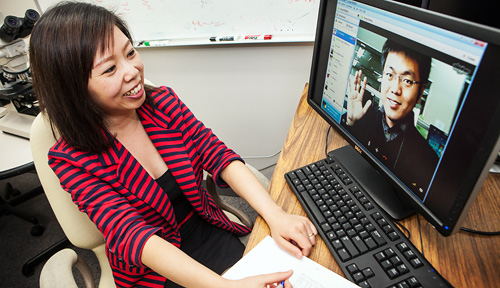It would take 275 four-gigabyte hard drives, or 6,000 complete sets of the seven-book Harry Potter series, to hold all the data researcher John Chan, M.D., has generated from 22 lymphoma biopsies.
If this seems overwhelming, it is — even to Dr. Chan.
All this data comes from patients who had an indolent form of non-Hodgkin lymphoma (NHL) called follicular lymphoma and subsequently developed a more aggressive tumor called transformed follicular lymphoma.
Dr. Chan, the Amelia and Austin Vickery Professor of Pathology, has studied NHL for more than 20 years and has received more than $12 million from the National Institutes of Health and the Lymphoma Research Foundation.
In 2011, 66,360 people were diagnosed with NHL and 19,320 died from the disease in the United States. Transformed follicular lymphoma can be managed with chemotherapy and stem cell transplants, but patient survival was poor.
“About 40 percent of the patients experience transformation and once that happens, the prognosis gets much worse,” Dr. Chan said.
“We want to discover the genetic abnormalities associated with the transformation and find molecular targets for treatment.”
In follicular lymphoma, the bcl2 (B-cell lymphoma 2) gene that regulates cell death, or apoptosis, is moved, or translocated, to a new place on the DNA where its normal function is altered. It also is believed to be involved in resistance to conventional cancer treatment.
“Everyone has two sets of chromosomes,” he said. “It’s an accident of nature to get the first translocation of the bcl2 gene. This molecular change then allows subsequent additional genetic changes responsible for the development of the lymphoma.”
Although UNMC’s Next Generation Sequencing core laboratory enabled Dr. Chan to generate enormous amounts of sequencing data quickly, he needed greater capacity and assistance to analyze the vast amount of data.
He turned to China.
For the past five years, China has poured trillions of dollars into biomedical research with the goal of becoming the global leader in life-science discovery and innovation. They have built five large capacity gene sequencing facilities, one of which is the Beijing Institute of Genomics (BIG) of the Chinese Academy of Sciences. With a computing capacity of more than 10 trillion calculations per second, BIG is focused on solving scientific questions through large-scale sequencing.
Enter Qiang Gong, a BIG graduate student and a bioinformatics expert, who was paired with WeiWei Zhang, a second-year bioinformatics graduate student in Dr. Chan’s lab. They worked for a while via email, but the 12-hour time difference and 10,628-mile distance hampered effective communication.
Dr. Chan used money from a University of Nebraska Foundation grant that had been set aside for global initiatives to bring Gong to Omaha for three months this past summer. The grant paid Gong’s travel and living expenses.
When UNMC students travel to China, the opposite will be true, Dr. Chan said.
By September, Gong had worked with Zhang to establish a new, efficient algorithm to analyze data from Exome sequencing of the follicular lymphoma and the transformed samples.
“We can discuss data all the time and see if we can come up with new methods of analysis,” said Zhang, who had originally come from China to obtain her master’s degree at the University of Nebraska at Omaha. “Throughout this project, scientists and staff in UNMC’s bioinformatics facility have been engaged and helpful. The University of Nebraska-Lincoln supercomputer cluster, Tusker, has served as a workhorse for the analysis.”
Dr. Chan expects to complete the analysis by January 2013, after which they will publish their results and Gong will be honored as a co-author.
